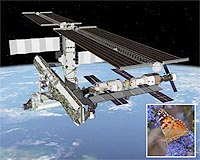 |
USAF Academy CO (AFNS) Nov 18, 2009 A U.S. Air Force Academy space weather experiment heads for the International Space Station aboard the Space Shuttle Atlantis after the shuttle lifted off at at 2:28 p.m. EST Nov. 16 from Cape Canaveral Air Force Station, Fla. Among the shuttle's many payloads on the 11-day mission is the Academy's Integrated Miniaturized Electrostatic Analyzer, or MESA for short. The MESA was developed and patented at the Academy's Department of Physics. It is a rugged, smart-skin sensor measuring plasma density, temperature and spacecraft charging as part of the Materials International Space Station Experiment 7. The MISSE-7 MESA sensor replaces a similar sensor deployed to the International Space Station on the MISSE-6 experiment. "The MESA that is going up to the space station replaces one that just came down from the space station. The major difference is that this time we will be able to use telemetry to get data "live" from the instrument. We are collecting 'space weather' data, basically the temperature and density of the plasma surrounding the space station," said Dr. Geoff Mcharg, the director of the Academy's Space Physics and Atmospheric Research Center. The experiment has a mass of 0.576 kilograms, a volume of 10x10/2.5 centimeters and a power requirement of only 0.25 watts, making MESA many times smaller than conventional space weather instruments. Data collected from the instrument will be analyzed by cadets, who helped build MESA. This experiment also continues the Academy tradition on developing future scientists and officers for the Air Force by having undergraduate cadets participate directly in the program. Share This Article With Planet Earth
Related Links ISS Station at NASA Station and More at Roscosmos S.P. Korolev RSC Energia Watch NASA TV via Space.TV Space Station News at Space-Travel.Com
 Butterfly experiment goes into space
Butterfly experiment goes into spaceCape Canaveral, Fla. (UPI) Nov 16, 2009 Monarch and painted lady butterfly larvae rode into space Monday aboard space shuttle Atlantis in an experiment to be monitored by thousands of U.S. students. The University of Colorado at Boulder butterfly larvae educational payload was designed and built by BioServe Space Technologies, a NASA-funded center located in the university's aerospace engineering department. CU-Boulder ... read more |
|
| The content herein, unless otherwise known to be public domain, are Copyright 1995-2009 - SpaceDaily. AFP and UPI Wire Stories are copyright Agence France-Presse and United Press International. ESA Portal Reports are copyright European Space Agency. All NASA sourced material is public domain. Additional copyrights may apply in whole or part to other bona fide parties. Advertising does not imply endorsement,agreement or approval of any opinions, statements or information provided by SpaceDaily on any Web page published or hosted by SpaceDaily. Privacy Statement |